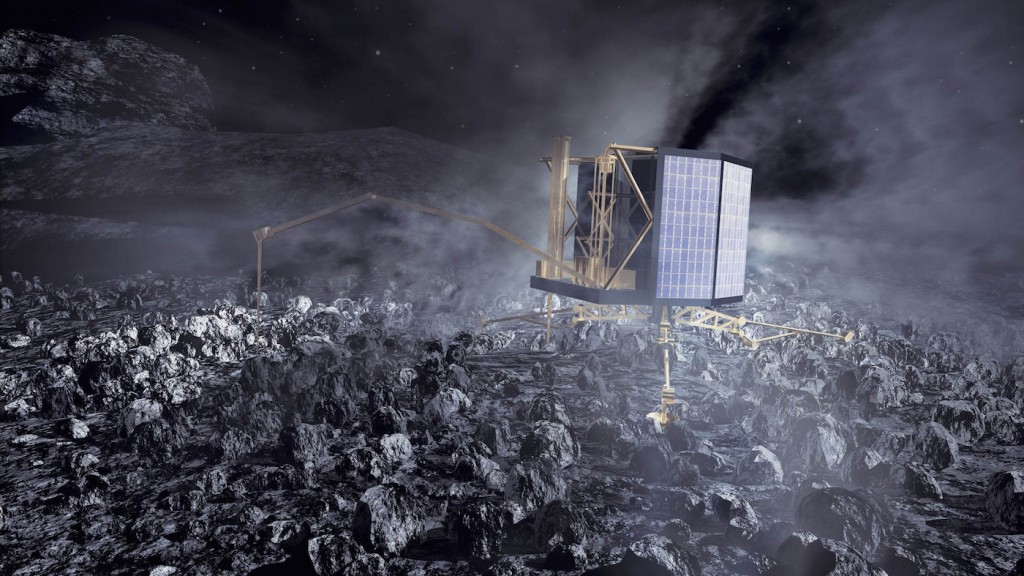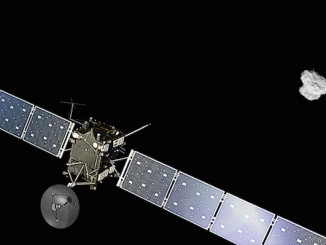
Europe’s Rosetta spacecraft is trying to contact the Philae landing probe for the first time since the robot fell silent after a bouncy landing on a comet in November.
Although there are slim odds of hearing from Philae in the first communications window this month, scientists remain cautiously optimistic the lander can wake up and resume operating at least some of its scientific instruments as comet 67P/Churyumov-Gerasimenko nears the sun later this year.
The first opportunity to contact Philae was Thursday, when ground controllers commanded the probe’s Rosetta mothership to call the lander. The resulting silence was not surprising.
“At the moment, we have not received any signal from Philae yet,” said Koen Geurts, an engineer at the lander’s control center in Cologne, Germany. “It could happen up to the 20th of March, although we’re not expecting too much because the temperatures are still very cold.”
“In case we do not receive any signal now, we will retry again in April when chances are higher because the comet will be closer to the sun,” Guerts said in a video update posted Friday.
Engineers last heard from Philae on Nov. 14, two days after it released from Rosetta and touched down on the comet, then bounced up to a kilometer (0.6 miles) across its nucleus over two hours. Philae ended up on a tilt wedged against a cliff or boulder that eclipses much of the light and heat coming from the sun, and the lander quickly drained its batteries without a way to recharge.
The probe returned images — the first pictures ever taken from the surface of a comet — and collected 16 megabytes of data over the following two days. That was about 90 percent of the data scientists expected to obtain during Philae’s initial operating period, according to Stephan Ulamec, the lander’s manager from the German Aerospace Center, or DLR.
“Philae currently receives about twice as much solar energy as it did in November last year,” Ulamec said in a press release. “It will probably still be too cold for the lander to wake up, but it is worth trying. The prospects will improve with each passing day.”
Officials have not pinpointed Philae’s location on the comet, but they have narrowed its final resting place within an error of 100 meters — about 330 feet — by analyzing radio signals exchanged between the lander and the Rosetta orbiter once the craft settled on the surface of the comet. The lander is about the size of a household washing machine, and it would appear just a few pixels across in imagery taken by Rosetta’s high-resolution science camera — and even then only when illuminated by the sun.

Rosetta, Philae and comet 67P are now about 300 million kilometers (186 million miles) from the sun. The comet is heading for perihelion Aug. 13, when the tiny world reaches the point of its orbit closest to the sun.
Seasonal variations on the comet should also make for a more favorable environment for Philae, giving its solar panels more sunlight over the coming months just as the comet nears the sun.
Engineers estimate Philae currently gets about 1.3 hours of sunlight for every 12.4-hour day on the comet.
When Philae stopped transmitting in November, the lander should have stayed alive. The probe was designed to go into a power-saving mode that directed all available electricity to keep the craft’s internal electronics from getting too cold, ceasing use of its radio and science instruments.
“At this time, we do not yet know that the lander is awake,” Geurts said. “To send us an answer, Philae must also turn its transmitter — and that requires additional power.”
Philae needs 19 watts of power to enable two-way communications with Earth via Rosetta, which continued its mission around comet 67P after dropping off the lander, conducting a series of flybys and observations as surface activity picks up with warmth from the sun.
The lander requires 5.5 watts of power and an internal temperature of at least minus 45 degrees Celsius (minus 49 degrees Fahrenheit) to wake up and listen for signals from Earth, and the control team in Cologne has developed commands to send to Philae to “optimize the heating and provide energy savings to improve its chances of communication with Earth,” DLR officials said in a press release.
Philae may not respond to the blind commands even if it receives the signals.
“At this time, we do not yet know that the lander is awake,” Geurts said. “To send us an answer, Philae must also turn its transmitter — and that requires additional power.”
Rosetta will attempt communications with Philae continuously until March 20, officials said, and the next opportunity to hear from the lander is in April.
If Philae sends a message, ground controllers will first evaluate the lander’s health before issuing orders to restart science operations.
“We will then evaluate the data,” Guerts said. “What is the state of the rechargeable battery? Is everything on the lander still functioning? What is the temperature? How much energy is it receiving?”
Even if the battery was damaged by the cold, Philae might still be able to collect data when it is in daylight. If the battery is functional, Philae could work around-the-clock.
“We are working to ensure that we can operate the lander and its instruments at least during the comet’s daytime, when it is in direct sunlight,” Guerts said.
Follow Stephen Clark on Twitter: @StephenClark1.



